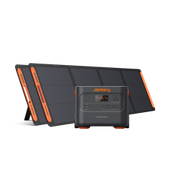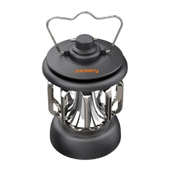When you purchase appliances for your home or kitchen, you’re bound to be curious about their energy requirements. You might be wondering how many amps a dishwasher uses or its running wattage. A typical household dishwasher uses 10 amps of power, whereas larger ones may use 15 or more amps.
You’ll find dishwashers in different sizes and capacities, each drawing different amounts of power. If you’re looking for an alternative way to power up your dishwasher or other appliances or simply want a form of power backup if you live in a place with frequent power outages, you may consider using a Jackery Solar Generator. These solar-powered generators are lightweight and portable, and their versatility allows you to use them at home or take them outdoors.
Key Takeaways
- An amp is typically defined as the amount of electricity flowing through a circuit at any given time.
- A typical household dishwasher will use 10 amps, whereas larger models may use up to 15 amps.
- There are a few ways to check the amperage of your dishwasher: Check the manufacturer’s details or the Energy Rating, use a power meter, or determine the amps from the appliance’s wattage.
Jackery Solar Generators are a safe, reliable, and versatile solution to run 99% of your household appliances, including a dishwasher.

How Many Amps Does a Dishwasher Use?
A typical household dishwasher uses 10 amps, but this can vary between 9 and 12 amps, depending on a few factors. Larger dishwashers can use 15 or more amps, and this will depend on the following factors:
- Size and Capacity:Smaller dishwashers will use less power, whereas larger ones with more features require more power.
- Heating Elements:Powerful heating elements will require a higher amperage than less powerful ones.
- Cycles and Modes:The modes you use and cycles you run, such as heavy-duty or high-temperature washes, will impact how many amps it uses.
However, before we dive into the details of how many amps a dishwasher uses, you must understand the meanings of a few key terms that play a key role here. These include amps, watts, and volts.
Amp (Amperage)
Amp, short for amperage, is the unit used to measure the amount of electricity flowing through a circuit at any given time. In other words, it refers to the rate at which current or the number of electrons flow through a wire, and it’s denoted by the letter ‘A.’ The formula to calculate the amps is given below:
Amps = Watts / Volts
Watts (Wattage)
An appliance’s wattage refers to the amount of electricity an electrical device or appliance consumes or the amount of power that it takes to make the appliance work. The wattage is calculated as a product of volts and amps and is denoted by the letter ‘W.’ The formula to calculate watts is given below:
Watts = Volts * Amps
Volts (Voltage)
Volts, short for voltage, refers to the pressure that pushes the electric current through the wire. It is also described as the speed at which individual electrons move through the circuit and is denoted by the letter ‘V.’ The power delivered in the United States is typically of two different voltages: 120 and 240 volts.
Volts = Watts / Amps
How Many Amps Does a Small, Medium, and Large Dishwasher Use?
When you’re in the market for a residential dishwasher, you’ll find it comes in three sizes. These depend on their capacity and range from small to medium and large. Each of these also draws different amounts of power, and their amp usage will also depend on their size, power efficiency, and respective operating conditions.
The table below offers a detailed breakdown of the typical amperage of these three sizes of household dishwashers.
|
Dishwasher Types |
Dishwasher Wattage |
Actual Energy Usage (Around 75% of dishwasher wattage) |
Amps (= Watts / Volts) |
|
Small Dishwasher |
1200-1500W |
900-1250W |
10-12.5 amps |
|
Medium-sized Dishwasher |
1500-1800W |
1250-1350W |
12.5-15 amps |
|
Large Dishwasher |
1800-2200W |
1350-1650W |
15-18.3 amps |
Note: The actual energy usage of a dishwasher might vary from the 25% mentioned, depending on the brand and the size.
How Many Amps Does a Dishwasher Draw on Startup?
The average dishwasher that consumes about 1300W of power when it's running will require at least about 1800W of electricity at 7.5 amps upon startup. Once it starts, it will reduce to 1300W at a lower amperage of 5.4 amps.
From what you can see above, you’ll notice that a dishwasher consumes a lot more electricity upon startup but then stabilizes to a steady 1300W (in this example) at just about 5.4 amps. The initial power surge is essential to get the dishwasher up and running, and the startup amps can be higher than the running amps.
This is where it becomes essential to understand the difference between the startup wattage and the running wattage of a dishwasher.
Startup Watts vs. Running Watts
The startup watts refer to the amount of energy required to run the dishwasher from idle. This value is generally, although not always, 2-3 times higher than the running watts. From the example above, you can see that a dishwasher with a running wattage of 1300W has a much higher startup wattage of 1800W.
The running wattage is the power the dishwasher consumes to run once it has settled into its normal operating mode. However, this, too, can change based on whether you’re using modes such as a high-temperature wash or a heavy-duty cycle.
To understand these concepts better, let’s take the example of a household dishwasher that runs on a 120-volt system and draws 5 amps of power.
Running Wattage = Voltage x Running Amps = 120V x 5A = 600W
Startup Wattage = Running Watts x 1.3 = 600W x 1.3 = 800W
Note: 1.3 has been derived from the estimate that the startup wattage is 25% higher than the dishwasher’s running wattage.
For more details, you should check out your dishwasher’s user manual to know whether or not it uses a startup or running wattage.
Startup Amps vs. Running Amps
Just like a dishwasher’s startup wattage is higher than its running wattage, the same principle also applies to its amperage. This spike in its amperage stabilizes to the dishwasher’s running amps after it’s started running normally for the course of the cycle. So, if you’re wondering how many amps does a standard dishwasher uses, you can use the following formula:
Startup Amps = Running Amps x 4 = 5A x 4 = 20A.
How to Calculate Your Dishwasher Amps
Calculating your dishwasher’s amperage is important for a few different reasons, including knowing how much energy it will consume so you can plan your appliance purchases better and know whether it’s running in optimum condition and requires any maintenance.
There are a few different methods to calculate your dishwasher’s amps. These are described below for your reference.
Method 1: Check the Manufacturer Details or the Energy Star Rating
The simplest way to check how much electricity your household dishwasher will consume is to check the details the manufacturer provides with the appliance. You can usually find these details on a label at the back of the appliance or in its user manual. You can even refer to the brand’s website for more information if you need it.
Most modern appliances, including dishwashers, come with an Energy Star rating, which references how energy efficient the appliance is, reducing the burden on your electricity bills.
According to the US Department of Energy, an Energy Star dishwasher uses approximately 12% less electricity and 30% less water than one without an Energy Star rating. You can use these details to calculate the appliances’ daily or hourly amp usage.
Method 2: Determine the Amps From the Wattage
Another simple way to check how many amps your dishwasher uses is to use the information about its wattage and voltage to calculate the amperage. As mentioned earlier, the formula to calculate this is:
Amps = Watts / Volts
So, for example, if you have a dishwasher that consumes 1200W at 120V, you can calculate the amps as follows:
1200W / 120V = 10A
Method 3: Use a Power Meter
Installing a power meter is another useful way of finding exactly how many amps your dishwasher uses. Installing it is simple: all you need to do is plug the power meter into the socket the dishwasher uses and then plug the dishwasher into the power meter.
A power meter is considered the most accurate means of calculating a dishwasher’s amperage as it also considers the appliance's operating conditions. The meter will also consider the power fluctuations during normal conditions, depending on the dishwasher’s brand.
Tips to Save Your Electricity Bill
With the global rise in the cost of fossil fuels, the cost of utilities like electricity is also steadily rising. As a result, people are increasingly looking for ways to run their household appliances more efficiently to reduce their electricity bills. Here are a few tips that you can consider to reduce your electricity bill when using a dishwasher:
- Don’t run the dishwasher with anything less than a full load, as this will consume more electricity and water. To maximize efficiency, you should also ensure that your dishwasher is fully loaded based on its specified capacity.
- Use the dishwasher’s energy-efficient modes and settings, such as the air-drying feature, instead of the heat-drying one. This is because the latter will consume more power. If your dishwasher is a newer model, it may even come with an Eco mode, which you can use to reduce energy and water consumption.
- Rinse your plates and other utensils before putting them in the dishwasher to reduce the number of pre-rises they need before they can be put through the wash cycle.
- If your dishes aren’t too dirty, you can also choose to use a shorter wash cycle to reduce the appliance's duration.
- Purchase an Energy Star dishwasher, as these are a lot more energy efficient. Even though they may cost more upfront, they will save you more money in the long run, especially since a dishwasher is a long-term investment.
Solar Generators for Dishwashers
If you’re in the market for the best manufacturers of solar generators, portable power stations, and solar panels, then look no further than Jackery. The Jackery Solar Generators seamlessly combine the Jackery Portable Power Stations and the Jackery SolarSaga Solar Panels.
When you place the solar panels under direct sunlight, they absorb solar energy from the sun’s rays and convert this to DC electricity. This is then passed through the pure sine wave inverter in the portable power station to convert it to AC electricity to run your dishwasher and other appliances.
You can make use of the appliance wattage chart to see which Jackery Solar Generator will be ideal for you.
Jackery Solar Generator 2000 Plus
The Jackery Solar Generator 2000 Plus is the brand’s expandable solar generator, offering enough capacity to run most household appliances, including a large dishwasher. The entire model is highly portable; you can fold the solar panels and take them wherever you want. The portable power station can also be wheeled with a handle. You can also charge it using ultra-fast solar charging or a wall adapter. This gives you an uninterrupted power supply, making it the ideal battery backup for your home.

Jackery Solar Generator 3000 Pro
The Jackery Solar Generator 3000 Pro is the brand’s large-capacity solar generator, which offers more than enough power to run large dishwashers and 99% of your household appliances in general. Like the previous model, it’s highly portable, so you can take it wherever you go. You can charge it via ultra-fast solar charging or a wall charger. This model is also cold-friendly, which means you can run it in places where temperatures witness significant drops without any effect on its performance.

Jackery Solar Generator 2000 Plus Kit (4kWh)
The Jackery Solar Generator 2000 Plus Kit (4kWh) is another capable solar generator with a large capacity that can charge 99% of your household or outdoor appliances. The batteries come with long-lasting reliability. You can also charge the system via ultra-fast solar charging or a wall adapter to keep your dishwasher running without hassles. The system is also free of fumes and is whisper-quiet, making it ideal and safe to use indoors to power up appliances like your dishwasher, among others.

|
Jackery Products |
Capacity & Output Watts |
Dishwasher Running Time |
|
Jackery Solar Generator 2000 Plus |
Capacity: 2042.8Wh Rated Output: 3000W |
Large Dishwasher (2000W) = 48 minutes Medium-sized Dishwasher (1600W) = 1H Small Dishwasher (1200W) = 1.4H |
|
Jackery Solar Generator 3000 Pro |
Capacity: 3024Wh Rated Output: 3000W |
Large Dishwasher (2000W) = 1.2H Medium-sized Dishwasher (1600W) = 1.6H Small Dishwasher (1200W) = 2.1H |
|
Jackery Solar Generator 2000 Plus Kit (4kWh) |
Capacity: 4085.6Wh Rated Output: 3000W
|
Large Dishwasher (2000W) = 1.7H Medium-sized Dishwasher (1600W) = 2.1H Small Dishwasher (1200W) = 2.8H |
FAQs About Dishwasher Amps
Is a 15 or 20-amp breaker for a dishwasher?
A 15A circuit is more than sufficient if it is dedicated to a dishwasher alone. However, if you’re adding other appliances or using a much larger dishwasher, then you should opt for a 20A breaker.
Does a dishwasher need a dedicated circuit?
Yes, dishwashers require a dedicated 120V, 15A circuit fed by a 15.2 NM wire with a ground.
Can you use a 15 amp outlet for a dishwasher?
Yes, a 15A socket with a 14/2 NM conduit is ideal for powering a small or medium-sized off-the-rack dishwasher. However, a larger dishwasher will require a 20A socket.
How many amps does a full-load dishwasher use?
A dishwasher with a full load will typically use 10-15A of power. This will also depend on its capacity and any additional features you use, such as high-temperature washes or heavy-duty cycles.
Conclusion
Understanding how many amps a dishwasher uses can be extremely helpful in enabling you to manage your energy consumption and find ways to make it a lot more efficient. While the average dishwasher will run at 10A, other larger dishwashers with higher capacities will use 10-15A or more. You should also understand how many amps your dishwasher uses on startup and what value it settles at when running normally.
If you’re relying on the electric grid to run all your appliances in a place that witnesses frequent power cuts or is prone to calamities that can result in blackouts, you should have some form of backup power supply. Jackery Solar Generators are ideal for such scenarios as they’re reliable, versatile, and can be charged using solar charging and a wall adapter, making them incredibly convenient.




















































































































Leave a comment